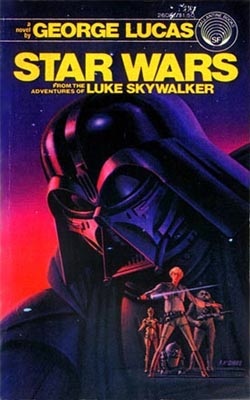Published in 1976—a full six months prior to the release of the film it was adapting—the novelization of Star Wars titled: Star Wars: From the Adventures of Luke Skywalker was billed as “a novel by George Lucas.” We now know (as Lucas freely admits in reprints of the book) that this book was in fact written by Alan Dean Foster, who created several specific aspects of the Star Wars backstory, many of which remain canon to this day. However, despite the wealth of terms and ideas that stuck, there are many, many differences between what we would come to know as Star Wars and what is contained in this book. Here are a few inconsistencies, differences and other curiosities originating from the first glimpse the public ever got of Star Wars.
Palpatine is Not a Sith Lord. Also, Not Even in Charge
In the film, an Imperial officer named General Tagge (didn’t even have to look that up) is moderately freaked out upon hearing that the “senate” has been dissolved. “How will the Emperor maintain control without the bureaucracy?” he worries. Well, in the prologue to the novel, the Emperor doesn’t. In a super-brief introductory section of the book (which claims to be taken from something called “The Journal of the Whills”) the death of the Old Republic and rise of the Empire is summarized quickly. Most interestingly, the rise of Palpatine from senator to President and then Emperor dovetails neatly with the events of the movie prequels. That is, until this casual assertion:
“Once secure in office he declared himself Emperor, shutting himself away from the populace. Soon he was controlled by the very assistants and boot-lickers he had appointed to high office, and the cries of the people for justice did not reach his ears.”
Palps is most certainly not a Sith Lord, nor does he even seem all that evil. Instead, he’s more like some creepy historical politician, like a Caesar being betrayed by a bunch of boot-licking Brutuses. Certainly not the cackling, all-knowing lightning-shooting guy we know so well. Also, how do we feel about the fact that the opening lines of the first ever item in the epic Star Wars franchise contains the phrase “boot-lickers?”
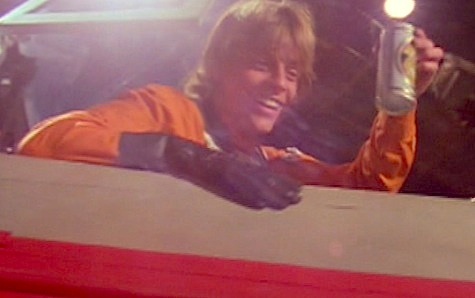
Gold Squadron? Never heard of them. Plus, big ups for Biggs!
Much of the rebel assault on the Death Star is depicted in the same manner as you see it in the film, but there are some changes. Superficially, the most noticeable differences are in the color designations. Instead of the Y-Wings being Gold Squadron, they’re Red Squadron, while the X-Wings of Red Squadron are now Blue Squadron. This means Luke is Blue 5 instead of Red 5. The drama of the battle itself plays out pretty much the same as in the film, but carries a slightly more somber tone.
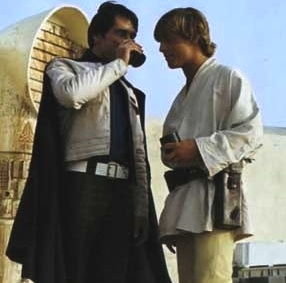 The friendship between Luke and Biggs is actually a big part of the Star Wars novel and, you could argue, helps to make Luke more realistic and relatable. This relationship is introduced in the beginning of the novel with the infamous deleted scene in which Luke observes the capture of the Tantive IV through his nifty space binoculars. Biggs is hanging out on Tatooine, and then shows up again twice more in the book. Right before the big battle they describe their friendship in terms of “two shooting stars,” a sentiment Luke repeats tearfully as Biggs dies tragically in his X-Wing. Further, it is Biggs and NOT Wedge who saves Luke’s ass from a TIE Fighter early in the battle. In the film, we mostly remember Biggs for his moustache. In the novel, he’s a real person.
The friendship between Luke and Biggs is actually a big part of the Star Wars novel and, you could argue, helps to make Luke more realistic and relatable. This relationship is introduced in the beginning of the novel with the infamous deleted scene in which Luke observes the capture of the Tantive IV through his nifty space binoculars. Biggs is hanging out on Tatooine, and then shows up again twice more in the book. Right before the big battle they describe their friendship in terms of “two shooting stars,” a sentiment Luke repeats tearfully as Biggs dies tragically in his X-Wing. Further, it is Biggs and NOT Wedge who saves Luke’s ass from a TIE Fighter early in the battle. In the film, we mostly remember Biggs for his moustache. In the novel, he’s a real person.
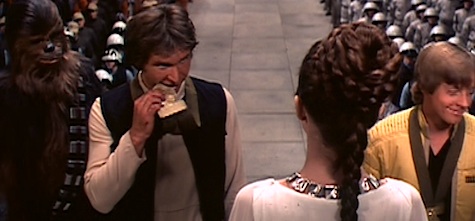
Chewbacca Gets a Medal!
Extensively parodied and complained about, the lack of a medal for Chewbacca is one of those small inexplicable events in Star Wars, on par with the gunners deciding not to shoot Threepio and Artoo’s escape pod in the beginning of the film. The Falcon requires two people to fly! And really, to run it properly, even more than that. So why didn’t Leia and those folks give Chewbacca a medal? Maybe they got the medals made beforehand and ran a statistical algorithm which told them that two survivors was the most likely outcome. Nobody wanted to spring for the extra medal, so Chewie was screwed. But in the book, he gets one, right before Luke.
Chewbacca shuffled nervously, giving every indication of wishing he were someplace else. Solo silenced him as Leia rose and came forward. At the same time banners tilted in unison and all those gathered in the great hall turned to face the dais.
She placed something heavy and golden around Solo’s neck, then Chewbacca’s—having to strain to do so—and finally around Luke’s.
Funnily enough, Alan Dean Foster describes these not as medals but instead as something heavy and golden. Kind of weird, right?
Obi-Wan Kills More People, Lives in a Cave, Smokes a Pipe
In addition to killing a few more fools who try to mess with him in the cantina, the book also depicts Obi-Wan Kenobi as a slightly more befuddled and screwy old man. First off, he lives in a cave and not a hut. Second, he smokes what is referred to as a “water pipe.” Is Obi-Wan hitting up some pipe weed, Gandalf-style? In his mind, Luke refers to Obi-Wan as an “oldster,” which though really silly, is sort of accurate. Kenobi rambles and says random stuff a lot in this book. Check it out:
“I understand you’re quite a good pilot yourself. Piloting and navigation aren’t hereditary, but a number of the things that can combine to make a good small-ship pilot are. Those you may have inherited. Still, even a duck has to be taught to swim.”
“What’s a duck?” Luke asked curiously.
“Nevermind.”
You really cannot make this stuff up. Apparently living in a cave and smoking whatever all day long has made Obi-Wan into philosopher of the totally obvious. Skills like piloting and navigation aren’t hereditary? I’m so glad you’re here to tell us these things.
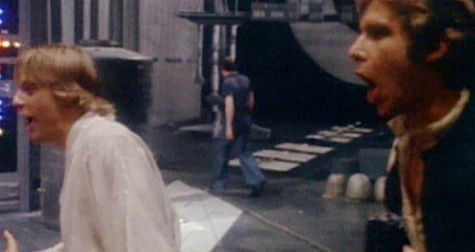
Other Oddities
- Droids are referred to as ’Droids, assuming that everyone understands this is a slang abbervation for the word “android.”
- The references to Earth crop up here and there. The “duck” mentioned above in the Obi-Wan section is an obvious example, but even in that same part of the book we get this sentence: “Luke’s mind was as muddy as a pond laced with petroleum.” Now that imagery would be weird even in a regular novel.
- It’s a bit unclear if Han shoots first in terms of the altercation between himself and Greedo in the cantina. Yes, it’s made plain that Han kills Greedo, but there is nothing there to say that maybe Greedo didn’t also fire. From the text: “Light and noise filled the litte corner of the cantina, and when it had faded, all that remained of the unctuous alien was a smoking, slimy spot on the stone floor.”
- The novel ends with Luke having lovey-dovey feelings about Leia. There’s no mistaking this—it’s not subtle at all: “Luke found that his mind was neither on his possible future with the Alliance nor on a chance of traveling adventurously with Han Solo and Chewbacca. Instead, unlikely as Solo claimed it might be, he found his full attention occcupied by the radiant Leia Organa. She noticed his unabashed stare, but this time she only smiled.” So, not only does Luke have a big crush on Leia, but he was also maybe considering going off on adventures with Han? Now, at least that part is kind of awesome.
There’s a lot more in this book which is off, awkward, and not at all like the film version of Star Wars: A New Hope, and yet the book is highly readable. To say it’s worth reading even if you haven’t seen the movie would be the claim of a crazy person, but if you like Star Wars, this novel will offer a bizzare glimpse into an alternate and twisted version of galaxy far, far away.
But you’ve been warned: if you face this novel, you face it alone. I cannot interfere.
Ryan Britt is a staff writer for Tor.com.










